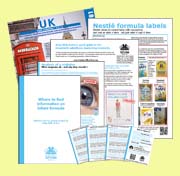European Parliament Resolution refusing the authorisation of DHA health claim and industry comment
Please see all the links to the relevant papers here:
http://info.babymilkaction.org/news/policyblog/dhabriefing
The whole Resolution is attached. The key paragraphs (J-S and 1-3) are on pages 4 and 5:
MOTION FOR A RESOLUTION pursuant to Rule 88(2) of the Rules of Procedure
by Glenis Willmott, Daciana Sarbu, Nessa Childers and Karin Kadenbach
B7-0000/2011
European Parliament resolution on the draft Commission regulation on the authorisation and refusal of authorisation of certain health claims made on foods and referring to children’s development and health
Here are the key paragraphs J-S, 1-3
J. whereas the health claim ‘docosahexaenoic acid (DHA) intake contributes to the normal visual development of infants up to 12 months of age’ is among the claims to be added to the Union list of permitted claims according to the draft Commission Regulation,
K. whereas generally accepted scientific evidence shows that DHA in breast milk contributes to the visual development of infants,
L. whereas the synthesised DHA added to formula milks and other foods intended for infants is, however, in a different biological environment to breast milk, which is a species-specific, living substance with co-enzymes and co-factors which allow the fats to work optimally,
M. whereas the opinions communicated by the EFSA to the Commission state that the panel could not have reached the conclusion that there is a cause and effect relationship between the intake of infant and follow-on formula supplemented with DHA and visual function without considering the studies claimed by the applicant as proprietary ,
N. whereas no studies were presented to EFSA investigating the effects of DHA supplementation on visual function starting at six months of age in infants receiving unsupplemented formula from birth ,
O. whereas the systematic review of evidence regarding DHA and neurological development in infants published by the Cochrane Library in 2008 found that that feeding term infants with milk formula enriched with DHA and other similar long chain fatty acids had no proven benefit regarding vision, cognition or physical growth,
P. whereas the report published in the British Medical Journal by Kathy Kennedy et al in June 2010 found that ten years after being fed with DHA fortified formula girls were on average heavier and had higher blood pressure,
Q. whereas there is a need for more research into the possible effects, both beneficial and harmful, of DHA supplementation before the use of DHA in follow-on formulae and foods for infants can be claimed as beneficial,
R. whereas the health claim on DHA and visual development referred to in the draft Commission Regulation could, therefore, be misleading and thus contrary to Article 3 point (a) of Regulation (EC) No 1924/2006 in the light of the objectives set out in Recital 10 of that Regulation,
S. whereas there is not a clear scientific consensus on the effect DHA fortified formulae have on infants, which runs contrary to the requirements laid down in Articles 5 and 6 of Regulation (EC) No 1924/2006 in the light of the objectives set out in Recitals 10, 14, 17 and 23 of that Regulation;
1. Considers that the draft Commission Regulation on the authorisation and refusal of authorisation of certain health claims made on foods and referring to children’s development and health is not compatible with the aim and content of Regulation (EC) No 1924/2006;
2. Opposes the adoption of the draft Commission Regulation;
3. Instructs its President to forward this resolution to the Council and the Commission, and to the governments and parliaments of the Member States.
Also attached is the comment from IDACE (the baby food industry in Europe) and an Aide Memoire from the European Commission.
IDACE's main claim is that there is broad consensus that the claim is substantiated by the totality of the Evidence. There is not.
The Commission too obscures the main point by saying: "The favourable EFSA assessment was based on studies made on DHA supplemented formulae. Therefore, it is shown scientifically that even DHA added in formulae has a health benefit for infants. Those studies were not confidential."
In a letter to the EU Commission (3rd Sept. 09) and in its opinion EFSA made it clear that there was no evidence to support the claim for follow-on formulas.
http://ec.europa.eu/food/food/labellingnutrition/claims/comments_efsa_en.htm
EFSA clarified position stating (my emphasis): "The claimed effect could be extended to weaning baby foods (as for follow-on formula) provided that the target population is infants either breast-fed until weaning or having received a DHA-enriched infant formula containing 0/3% of fatty acids as DHA from birth until weaning. The evidence, however, does not establish that starting DHA supplementation at 4-6 months in infants who had received a control (DHA-free) formula in the first months of life would have an effect on the visual development of those children....... "there are no data from specific randomised control trials supporting a benefit of DHA supplementation starting at 6 months of life in infants fed a DHA-free formula in the first 6 months of life....... European legislation (Directive 2006/141/EC) allows supplementation of infant formulas with DHA, but such fortification is not mandatory."
The 1989 PARNUTS Directive (Council Directive on Foodstuffs Intended for Particular Nutritional Uses (89/398/EEC) transferred the power to initiate and finalize legislation on baby foods to the European Commission, with no need to consult Parliament. PARNUTS is on the agenda of the Employment, Social Policy, Health and Consumer Affairs Committee on 6-7th June - so it makes perfect sense to wait and not allow this misleading claim to slip through on the basis of no real evidence.
http://ec.europa.eu/food/food/labellingnutrition/nutritional/index_en.htm
http://register.consilium.europa.eu/pdf/en/10/st16/st16030.en10.pdf
| Attachment | Size |
|---|---|
| Resolution.doc | 58.5 KB |
| IDACE DHA.pdf | 50.34 KB |
| CommissionDHA.doc | 63 KB |
| EFSA to Basil DHAsm.pdf | 3 MB |
- Login to post comments






